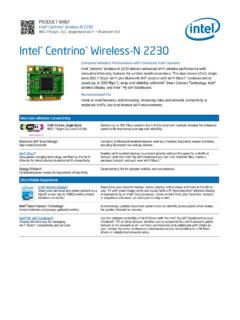Transcription of The Next Hyper Connected Experience for All.
1 The Next Hyper Connected Experience for All. 6G Issued by Samsung ResearchSamsung 6G VisionThe Visionof 6 GBring the next Hyper - Connected Experience to every corner of life. Preface 71 Megatrends toward 6G 9 Connected Machines Machine as a Main User 9AI New Tool for Wireless Communications 11 Openness of Mobile Communications 11 Social Goals and Mobile Communications 122 6G Services 13 Truly Immersive XR 13 High-Fidelity Mobile Hologram 14 Digital Replica 153 Requirements 17 Performance Requirements 18 Architectural Requirements 19 Trustworthiness Requirements 204 Candidate Technologies 22 Terahertz Technologies 22 Novel Antenna Technologies 24 Evolution of Duplex Technology 27 Evolution of Network Topology 28 Spectrum Sharing 30 Comprehensive AI 32 Split Computing 33
2 High-Precision Network 355 6G Timeline 376 Concluding Remarks 387 References 39 Table of Contents PrefacePreface7 Preface Following the commercialization of 5G technologies, both academia and industry are initiating research activities to shape the next-generation communication system, namely 6G. Considering the general trend of successive generations of communication systems introducing new services with more stringent requirements, it is reasonable to expect 6G to satisfy unprecedented requirements and expectations that 5G cannot expect that 6G will provide ultimate Experience for all through Hyper -connectivity involving humans and everything.
3 In this white paper, we aim to provide readers with a comprehensive overview of various aspects related to 6G, including technical and societal trends, services, requirements, and candidate technologies. The rest of this white paper is organized as follows: Section 1 introduces megatrends driving technology evolution towards 6G. Section 2 discusses major services that have to be taken into account in developing 6G technologies. Section 3 describes requirements to realize the expected services for 6G. They consistof performance requirements, architectural requirements, and trustworthiness re-quirements.
4 Section 4 introduces candidate technologies that will be essential to satisfy the re-quirements for 6G, which currently include support of the terahertz band, novel an-tenna technologies, evolution of duplex technology, evolution of network topology, spectrum sharing, comprehensive AI, split computing, and high-precision network. Section 5 provides an initial expectation of the 6G timeline. We anticipate that the ear-liest commercialization could occur as early as 2028 while massive commercialization may emerge around 2030. Section 6 provides concluding toward 6G Megatrends toward 6G1 Applications that take advantage of wireless communications are ex-panding from connecting humans to connecting various things.
5 Wireless communication is becoming an important part of social infrastructure and people s daily lives. In addition, today s exponential growth of advanced technologies such as artificial intelligence (AI), robotics, and automation will usher in unprecedented paradigm shifts in the wireless communi-cation. These circumstances lead to four major megatrends advancing toward 6G: Connected machines, use of AI for the wireless communica-tion, openness of mobile communications, and increased contribution for achieving social goals. The rest of this section discusses details of these four MachinesMachine as a Main UserIt is envisaged that the number of Connected devices will reach 500 bil-lion by 2030 [1], which is about 59 times larger than the expected world population ( billion [2]) by that time.
6 Mobile devices will take various form-factors, such as augmented reality (AR) glasses, virtual reality (VR) headsets, and hologram devices. Increasingly, machines will need to be Connected by means of wireless communications. Examples of connect-ed machines include vehicles, robots, drones, home appliances, displays, smart sensors installed in various infrastructures, construction machiner-ies, and factory equipment. Figure 1 illustrates this trend of mobile devices and Connected the number of Connected machines grows exponentially, those ma-chines will become dominant users of 6G communications.
7 Looking back at the history of wireless communications, technologies have been devel-oped assuming services for humans as the major driving applications. In 5G, machines were also considered in defining requirements and devel-oping technologies. We expect new 6G technologies have to be developed specifically to connect hundreds of billions of machines taking into account what is required for provide an initial insight into the performance targets needed for Connected machines, Table 1 compares the perception capability of hu-mans and machines. For example, the capability of human eye is limited to a maximum resolution of 1/150 and view angle of 200 in azimuth and 130 in zenith.
8 On the other hand, machine vision capability is not con-strained by such limitations, since it can take advantage of many cameras with various functions. Considering such high capabilities of machines, the performance requirements for the 6G system could be extremely high for relevant service 1 Evolution of mobile devices and Connected 1 Comparison of the perception ca-pability of humans and machines. Human MachineMaximumResolution1/150 (Smartphone display 290 ppi at 30 cm)Exceeds Human Limitations!LatencyPerception<100 msAudibleFrequency250-2,000 HzVisibleWavelength280-780 nmViewingAngleAzimuth 200 , Zenith 130 20202010203011 Megatrends toward 6G AINew Tool for Wireless Communications In recent years, the rise of AI has pervaded various areas such as finance, health care, manufacturing, industry, and wireless communication sys-tems.
9 Application of AI in wireless communications holds the potential to improve performance and reduce capital expenditure (CAPEX) and opera-tional expenditure (OPEX). For example, AI can Improve performance of handover operation taking into account network deployments and geographical environments Optimize network planning involving base station (BS) location de-termination Reduce network energy consumption Predict, detect, and enable self-healing of network anomaliesThe potential benefits of AI applied to wireless communications are promising. On the other hand, there is a limit to what is achievable today, as use of AI in communication networks was not considered when develop-ing existing communication systems such as 5G.
10 In the case of 6G, knowing that AI technologies are available for practical applications, we can develop a system that takes into account the possibility of embedding AI in various entities comprising wireless networks and services. A tremendous amount of data associated with hundreds of billions of Connected machines and humans needs to be collected and utilized in 6G AI from the initial phase of developing concepts and tech-nologies for 6G will give us more opportunities to take advantage of AI for improvement of overall network operation in terms of performance, cost, and ability to provide various of Mobile CommunicationsSubstantial improvements of the computing power of general purpose processors such as central processing units (CPUs) and graphic processing units (GPUs)



